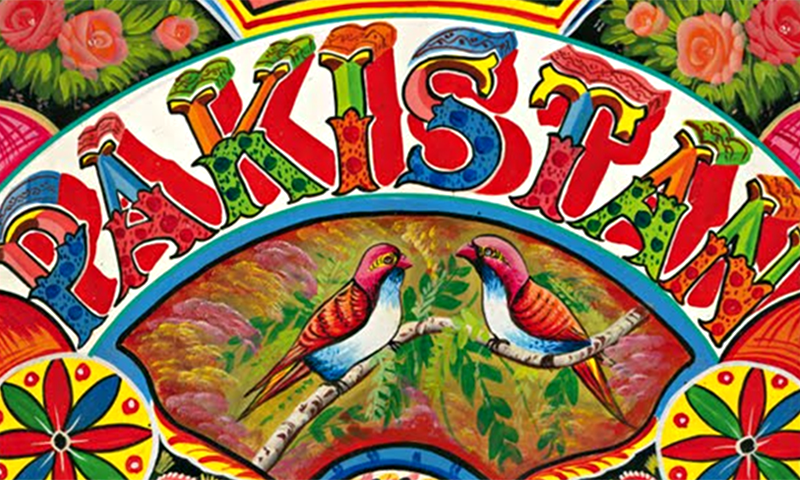Pakistan Ideology
A term first used during the military regime of Field Martial Ayub Khan in 1962. Ayub had taken over power in a military coup in 1958. In 1962 he introduced a new constitution.
The government described the constitution as an encapsulation of the vision and ideology of Pakistan’s founder Mohammad Ali Jinnah.
This vision (according to the government) was about building Pakistan with the help of a strong centralised state and government; a robust economy based on rapid industrialisation and the modernisation of agriculture; the promotion of a united culture driven by the progressive notions of Islam, the modern sciences and technologies.
 |
| Ayub believed himself to be a Pakistani Ataturk and a South Asian De Gaulle. Here, he poses in front of a painting showing the proto-liberal Mughal King Akbar. |
The right-wing Jamat-i-Islami (JI) and the centre-right Muslim League-Council (an opposing faction of the Muslim League that was being headed by Ayub), accused Ayub of introducing ‘overtly secular’ policies. The Council League’s member, Chaudhry Khaliquzzaman, told the then parliament that policies should be devised according to the dictates of the ‘Pakistan Ideology.’ He didn’t mention exactly what these dictates were, or for that matter, what was Pakistan Ideology (because the founders had not used this term).
The JI echoed the aged Chaudhry’s proclamations. It described Pakistan Ideology to mean a country that was inspired and driven by the ‘Islamic character’ of the Pakistan society and an idea that eschews secular and ‘westernised’ influences in the country and replaces them with an ‘Islamic culture’ and an ‘Islamised polity.’
The Ayub regime rejected the JI’s notion of Pakistan Ideology as being retrogressive and a way to snatch power by the clergy.
 |
| Islamic scholar and founder of JI at an ulema reception in Saudi Arabia (1973). He opposed Ayub and Bhutto’s versions of the Pakistan Ideology but became the main inspiration behind Zia’s understanding of it. He passed away in 1979. |
In the late 1960s, when Ayub was facing a widespread protest movement that was being led by leftist parties and student groups (against his alleged ‘capitalist cronyism’ and authoritarianism), some intellectuals belonging to the left-liberal and populist Pakistan Peoples Party (PPP) claimed that Jinnah’s vision foresaw a Pakistan that was multicultural, progressive, democratic and driven by a socialist economy.
During the short General Yahya Khan dictatorship (1969-71), the government explained the Pakistan Ideology to simply mean Jinnah’s ‘Two Nation Theory’ that was behind the creation of a separate Muslim-majority state in South Asia.
But after a brutal civil war in the eastern wing of the country (former East Pakistan) saw the wing breakaway and become Bangladesh (December 1971), the government (now headed by PPP’s chairman, ZA Bhutto), invited a wide range of historians and intellectuals (from both the left and right sides of the divide) to debate and churn out a state ideology that would help the rest of the country and its various ethnic groups remain intact as an ideological whole.
This exercise culminated in 1973 and suggested an ideology that was a fusion of sorts of the views on culture, history and politics of those who wanted to see a progressive, plural and multicultural Pakistan and those who demanded that it evolve into becoming an ‘Islamic state.’
So in the 1970s, the Pakistan Ideology came to mean the enactment of a state, government and society whose progressive and plural tenor was inspired by the egalitarian and unifying notions of Islam. The ideology also envisioned a strong and sturdy state that would strive to outpace India (and other ‘enemies’) in the fields of economy and military defence.
 |
| ZA Bhutto signing a portrait of himself in 1975. His populist regime (1971-77) tried to blend socialism with democratic populism and certain aspects of Political Islam. Under him, the Pakistan Ideology meant a national evolution towards creating a state and nation that was progressive and multicultural, driven by egalitarian notions of Islam and an aggressive stance against India. He was toppled in 1977 in a military coup and then hanged (through a controversial trial) in 1979. |
In the late 1970s when Bhutto saw himself pressed by a protest movement by a large alliance of religious and right-wing parties (who accused his government of being ‘un-Islamic’, authoritarian and decadent), his religious opponents claimed that they alone could implement the ‘true Pakistan Ideology.’
This ‘true Pakistan Ideology’ eventually became a project of the General Ziaul Haq dictatorship. He toppled the Bhutto regime in July 1977.
During his 11-year rule, Zia remoulded the concept of the Pakistan Ideology and turned it into a dogma that explained Pakistan as a unique emergence in the Muslim world that was conceived to become a bastion of faith and an Islamic state driven entirely by ‘divine laws.’
What made it a dogma (that was aggressively proliferated through school textbooks and propaganda), was that it refused to recognise the multi-ethnic and multi-sectarian make-up of the country and instead, offered a rather convoluted, rigid and artificial understanding of the faith.
This ended up promoting inelastic and entirely myopic strands of the faith, pushing them from the fringes of society into the mainstream and in the process, retarding the natural evolution of Pakistan’s multicultural ethos and polity. It also ended up offending various Muslim sects and sub-sects, creating serious sectarian tensions. It alienated the ‘minorities’ as well.
 |
| The Pakistan Ideology project reached its limit during the Ziaul Haq dictatorship. It was turned into a rigid dogma that many believe created social, political and sectarian fissures in the society. |
Current status: The Pakistan Ideology project reached its limit during the Zia regime. The shape that it finally took was so inflexible that it could not adapt to the rapid political changes that followed after the end of the Cold War (1989) and during the emergence of the severe forms of religious extremism and terrorism that engulfed the country after 9/11.
It can thus be suggested that the project is now facing extinction – not only due to the fact that it stopped evolving, but also because Pakistan ruling and military establishments and intelligentsia are now trying to replace it with a thinking that would directly challenge the doctrinal rigidity and the political and cultural isolation the so-called ideology ended up promoting and encouraging.
 |
| The current military chief, General Raheel Sharif, is said to be the central architect of the changing narrative in the military-establishment that is now gradually filtering out various dogmatic ideological convolutions introduced into the forces during the Zia regime. |
The Pakistan Culture
What is ‘Pakistani culture?’ After 67 years of independence, a culture has indeed developed but only rarely has it been studied and documented. Instead, much of the effort in this context has gone into determining and then advocating what should be (as opposed to what is) Pakistani culture.
But there have been exceptions...
Over the years, some truly remarkable intellectual exercises have taken place to study what is (and/or should) constitute Pakistani culture.
Pakistan was spun into a reality in 1947 through a nationalist theory that described the Muslims of India as being a separate cultural and political entity in the region.
The left and liberal supporters of the country’s founder, Mohammad Ali Jinnah, understood his separatist impulse as an attempt to create a Muslim-majority country that would inherently negate the environment of communal strife that had engulfed India at the time.
To the liberals and those on the left, Jinnah had envisioned a separate country as being a haven of communal harmony because it would have a majority that was once a ‘persecuted minority’ in India. This way (theoretically), Pakistan was more likely to eschew and escape the historical and political currents that had plunged India into a riotous religious and communal whirlpool.
But whereas the liberals and those on the left saw the separatist aspect behind the movement that created Pakistan as a purely political manoeuvre to rescue India’s Muslim minority from the rising tide of communal strife in pre-partition India, those on the right understood it in more theological terms:
They understood the creation of Pakistan as being the first step to enact an Islamic State in South Asia that would then be expanded into other regions as a possible caliphate.
For this, they saw Jinnah’s move and achievement simply as a stepping stone – a moment in time from where the political leadership must fall into the hands of religious scholars and ‘pious men’ who would kick-start their campaign by ‘Islamising’ the society from below (through Islamic evangelism) so society could be prepared to willingly accept ‘Islamic laws’ imposed from above (the state).
Those on the right (along with the ‘moderate’ state) completely ignored the dynamics of the cultures of the country’s various ethnic, religious, sectarian and sub-sectarian communities that were contributing in the construction of Pakistan’s culture as a whole.
Instead, they ended up offering a rather absolutist (if not entirely naïve) idea of faith and culture (in Pakistan) emitting from a small upper-middle-class elite that was neither liberal nor entirely conservative.
 |
| The founder: Jinnah is seen as a progressive and pragmatic man by the left and the liberal intelligentsia of Pakistan who envisioned a multicultural Muslim-majority state; whereas the right understands him to be the man who provided the stepping stone from where Pakistan should have jumped to create an Islamic State. |
Such perceptions would begin to be challenged by the progressives in the 1960s.
Their conclusion was that the Pakistani culture was a combination of cultures – driven and energised by the individual cultures of the various Islamic sects and ethnic groups present here.
They added that Pakistan’s culture was also being contributed to by elements of Western culture inherited by the country from the region’s colonial past; and by the distinct cultures of various minority groups residing in Pakistan.
To them, Pakistan’s culture is naturally pluralistic and not monolithic. To them, Pakistan has its own culture that has many aspects, one of which was Islam.
This also meant that Jinnah had strived to safeguard a number of varied cultural, economic and political aspects associated with India’s Muslims and that religion alone was not the sole reason behind Pakistan’s creation.
 |
| Pakistani culture is not monolithic. It is diverse. A combination of various ethnic, sectarian and sub-sectarian cultures and of historic South Asian and Arab elements and certain modern western influences. Pakistani nationhood binds them together. |
Whereas the rightists condemn the liberal points of view on Pakistani culture as being a confused mixture of acts ‘aping the West’ and displaying the desire to retain certain unwanted ‘Hindu practices’, the liberals have mocked the rightists for failing to mould an identity that was in tune with the historical trajectories of Pakistan’s various stands of Islam and its ethnicities.
They accuse the rightists of ‘aping the Arabs’ (especially those from oil-rich monarchies), and for encouraging Pakistanis to behave like ‘fake Arabs’ and even second-class Muslims.
 |
| The rightists have accused the liberals of ‘aping the West’ … |
 |
| … the rightists in turn have been accused for ‘aping the Arabs’. |
Current status: The official understanding of Pakistani culture remains to be vague. The state has yet to fully accept it as being a historic amalgamation of various ethnic, religious and sectarian cultures that have been evolving in the region for hundreds of years.
Pakistani culture is not monolithic. It is diverse.
Also, there is nothing all that perturbing about this culture adopting certain positive influences arriving from outside, because if (to the conservatives), ‘western influences’ or ‘non-Islamic stimuluses’ are alien to what they consider to be Pakistani culture, then so are influences arriving from oil-rich lands in Arabia that have negated and alienated the indigenous religious impulses of Pakistan.
Pakistan has its own indigenous strands of liberalism as well as conservatism that are rooted well within the dynamics of how we as a pluralistic society and people along the River Indus have evolved over the centuries.
As we have seen, cultural engineering to override Pakistan’s diversity and replace it with a singular ideological and social convolution will continue to spell disaster and undermine the more organic aspects of Pakistani nationhood.
Pakistan culture — Diversities in motion
 |
| Fire and flair: Female students at a college in Karachi learn Taekwondo (a Korean Martial Arts sport) in 1948. |
 |
| Slow and steady: A camel cart races past a tram in Karachi in 1950. |
 |
| Fishing for food: A painting of a mermaid at a street restaurant in Lahore in 1952. (Photo by Frank Horvat). |
 |
| On the prowl: The Pakistan cricket team in England (1954). |
 |
| That little green drink: The first bottle of Pakistan’s ‘national soft drink,’ Pakola. The drink was launched by Mehran Bottlers on Pakistan’s third anniversary on August 14, 1950. Shape of the bottle has gone through many changes, but the colour and taste of the drink remains the same: Foggy green and bitter-sweet. |
 |
| Johnnie talking: An Urdu ad of Johnnie Walker Whiskey from an Urdu weekly published from Karachi in 1959. The ad claims that folks chose Johnnie Walker after sunset to liven up their evenings. |
 |
| Wake me up when Kashmir’s free: A man takes a nap in the backseat of a car with a poster demanding the liberation of Kashmir (from India) in Karachi (1956). |
 |
| Comrades: Progressive Urdu poet, Faiz Ahmed Faiz, at a café with friend and leader of the Communist Party of Pakistan (CPP), Sajjad Zaheer. Both Faiz and Zaheer were arrested in 1951 for planning a ‘communist coup’ against the government with Major-General Akbar Khan. Faiz was released in 1957. |
 |
| Walking tall: Stewardesses of Pakistan International Airline (PIA) on the runaway of Karachi Airport (in 1960). The uniforms of PIA hostesses were at the time designed by famous French designer, Pierre Cardin. PIA became one of the top 10 airlines of the world till it began its slow decline from the early 1980s onwards. |
 |
| Lahore buzz: Neon sign of Pakistani beer brand, Murree, on the roof of a café in Lahore in 1960. |
 |
| Peshawar waits: Peshawar prepares to welcome the US First Lady Jaqueline Kennedy in 1962. |
 |
| A 1962 mural by Pakistani painter Sadequain celebrating famous Muslim scientists and philosophers. |
 |
| Gringo ride: American tourists bargaining with a Rickshaw driver outside Dean’s Hotel in Peshawar in 1963. |
 |
| Shrine of a Sufi Saint in the Sindh city of Dadu illuminated after being given a make-over in 1963 (Photo from LIFE Magazine, April 1963). |
 |
| A 1964 press ad about Filipino and Moroccan dancers performing at the ‘007 Club’ at Karachi’s Beach Luxury’s Hotel. The Club is now a conventional restaurant (but still called 007). |
 |
| Brawn to rule: Pakistani bodybuilder, Ishaq Baig, on his way to winning the title of Mr. Asia in 1964. |
 |
| A classical dancer performs her art during the first ever television transmission in Pakistan in November 1964. |
 |
| Moving forward: An ad that heavily alludes to the Ayub regime’s emphasis on progress through industrialisation and science. |
 |
| Press ad of Karachi’s Hotel Excelsior. The hotel shut down in the late 1970s. Its club largely catered to middle-class Karachiites. |
 |
| Strongmen: President Ayub Khan with legendary Pakistani wrestlers, the ‘Bholu Brothers’ at the Presidency in 1967. The Brothers were considered to be some of the finest wrestlers in the world at the time. |
 |
| Thousands attend Eid prayers at Lahore’s Badshahi Mosque in 1967. |
 |
| Bad girls, astronauts and a Psycho: Karachi’s famous Rio Cinema in 1967. Rio was pulled down in the 1990s and turned into a gaudy ‘shopping arcade.’ |
 |
| Rashid Ahmed Khan, a prominent leader of the left-wing National Students Federation (NSF, surrounded by supporters at Karachi’s Dow Medical College soon after an NSF-led protest movement forced Ayub Khan to resign in 1969. |
 |
| The first in line: Pakistan’s first mainstream pop star, Ahmed Rushdi, performing on Pakistan Television (PTV) in 1970. |
 |
| The populist rises: ZA Bhutto speaking at a Pakistan People’s Party (PPP) and NSF rally at Karachi’s Nishtar Park during the 1970 election. (Picture: Sohail L. Lari). |
 |
| Star stuff: Leading Pakistani film actors of the 1970s, Nadeem and Waheed Murad, in Lahore in 1973. |
 |
| Students relax at the Karachi University in 1973. |
 |
| Two women chat at Karachi’s Clifton Beach (1972). |
 |
| Repair work being undertaken on Safina-e-Hujjaj in 1972. The Hujjaj was a massive cruise-liner that was custom-built to take Pakistani pilgrims to Saudi Arabia to perform the annual Muslim pilgrimage, Haj. |
 |
| Nightlife: Victoria Road in the Saddar area of Karachi in 1974. Between 1960 and 1977, the area was a famous for its trendy shops, restaurants and bars. |
 |
| Akbar lives: A vibrant 1973 poster printed by the Pakistan Ministry of Tourism to attract tourism to the city of Lahore. |
 |
| Jamming: A pop band of Pakistani Christians performing at Karachi’s Horseshoe Club & Restaurant in 1974. The club closed down in 1977 and then the restaurant in the early 1980s. |
 |
| The magic bus: European tourists wait for a bus in Pakistan’s arid Balochistan province in 1975. |
 |
| A 1975 press ad of the then famous Pakistan cigarette brand, Red & White. |
 |
| A 1974 ad propagating the Bhutto regime’s socialist/nationalisation policies. |
 |
| Raunchy: A still from Pakistan’s first ‘X-rated’ film, ‘Dhulan Aik Raat Ki’ (1975) that starred ‘Pakistan’s Charles Bronson’, Badar Munir. |
 |
| Homage to the founder: Especially struck coins issued on the 100th birth anniversary of Mohammad Ali Jinnah in 1976. |
 |
| Aziz Mian and the Sabri Brothers sold millions of albums of Sufi devotional music (Qawaali) in the 1970s. |
 |
| Two’s a company: Pakistan fast bowler, Imran Khan, and batsman, Javed Miandad, relax during a Test match against Australia (at Sydney) in 1976. Imran picked up 12 wickets in the match and helped Pakistan win its first Test on Australian soil. Both Khan and Miandad would become the two leading mainstays of Pakistan cricket across the 1980s. |
 |
| And the band looked on: A family of wedding musicians stand at the window of their home in Rawalpindi in 1977. |
 |
| The April 1977 cover of popular Urdu fashion and show-biz magazine, Dhanak. |
 |
| The inside flap of a 1976 issue of Ishtraq – Pakistan’s Urdu equivalent of Playboy magazine. The magazine was shut down in 1977. |
 |
| A new blue: A blue PIA aircraft. These limited-edition blue planes were especially commissioned for flights over Europe in 1977. PIA was still one of the leading airlines in the world before its gradual decline from the mid-1980s onwards. |
 |
| An elephant carries a teenage acrobat girl at a circus in Lahore in 1978. |
 |
| The tide turns: The March 1977 cover of a conservative Urdu magazine showing a rally and leaders of the right-wing anti-Bhutto alliance, the PNA. The PNA refused to accept the result of the 1977 election and began a widespread agitation against Bhutto’s ‘decadent’ regime. He was toppled in a reactionary coup by General Ziaul Haq in July 1977. |
 |
| When we were kings: Pakistan hockey captain Islahuddin shows the Hockey World Cup trophy to fans and media at the Karachi Airport in 1978. This was the second time Pakistan had won the Hockey World Cup. It would go on to win it twice more (1982, 1994) before the game began to decline in the country. |
 |
| Zia’s whip: A policeman prepares to publically flog an anti-Zia activist in Lahore in 1978. Dozens of anti-Zia journalists, student activists and political workers where publically flogged between 1978 and 1983. |
 |
| It begins: One of the first batches of Afghan insurgents arrives to set shop in Pakistan in January 1980. The insurgents were aided by United States, Saudi Arabia and Pakistan to fight the Soviet-backed regime in Afghanistan. |
 |
| Karachi’s famous Hotel Intercontinental (now Pearl Continental) during the New Year’s Eve of 1980. |
 |
| A bank in the middle of a small village in the Punjab (1980). |
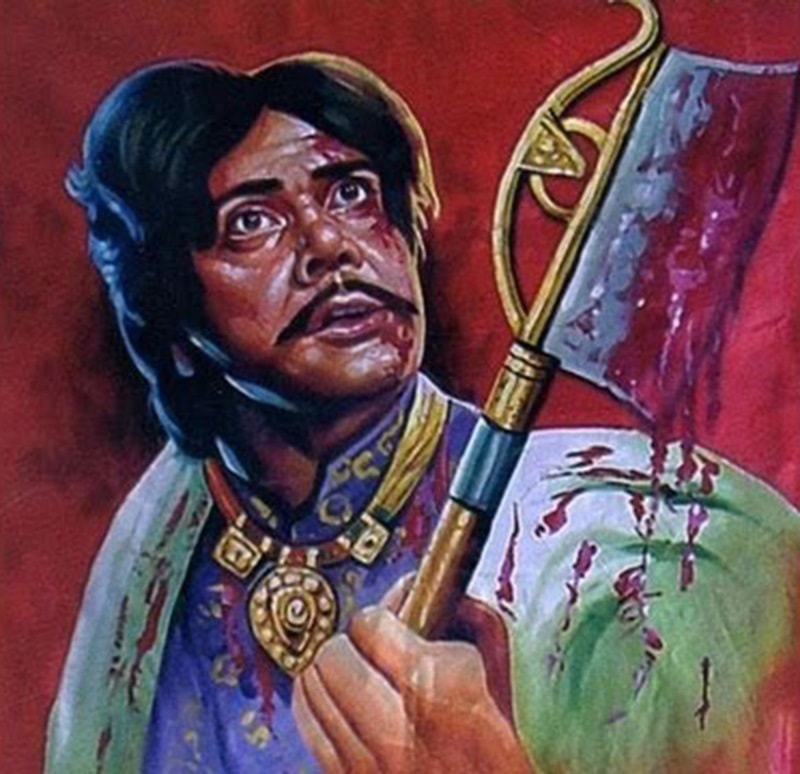 |
| Pulp Punjabi: A 1980 hand-painted billboard of Punjabi action hero, Sultan Rahi (as Maula Jat). The film Maula Jat was an instant hit thanks to its snappy dialogues, craggy violence and raunchy dances. It turned Rahi into a super star. Punjabi film industry boomed after the collapse of the Urdu film industry. |
 |
| Disco days: Pakistani pop duo, Nazia & Zoheb, performing their first major hit, Disco Deewane on TV in 1980. They were banned in 1981 by the Zia regime but the ban was soon lifted. |
 |
| The Pope comes to town: Children present Pope John Paul II flower bouquets at the Karachi Airport in 1981. The Pope addressed a large gathering of Pakistani Catholics at Karachi’s National Stadium. |
 |
| Renegade: Notorious left-wing Pakistani terrorist, Salamullah Tipu, on the steps of the PIA plane that he hijacked (with three other radicals) in 1981. He escaped to Kabul where he was killed in 1984. |
 |
| Shaming the dictator: Activists of the Women Action Front (WAF) burn their dupattas (long sacrfs) in Lahore in 1983. The WAF was on the forefront of opposing the Zia regime that it accused of being ‘anti-women’ and ‘regressive.’ |
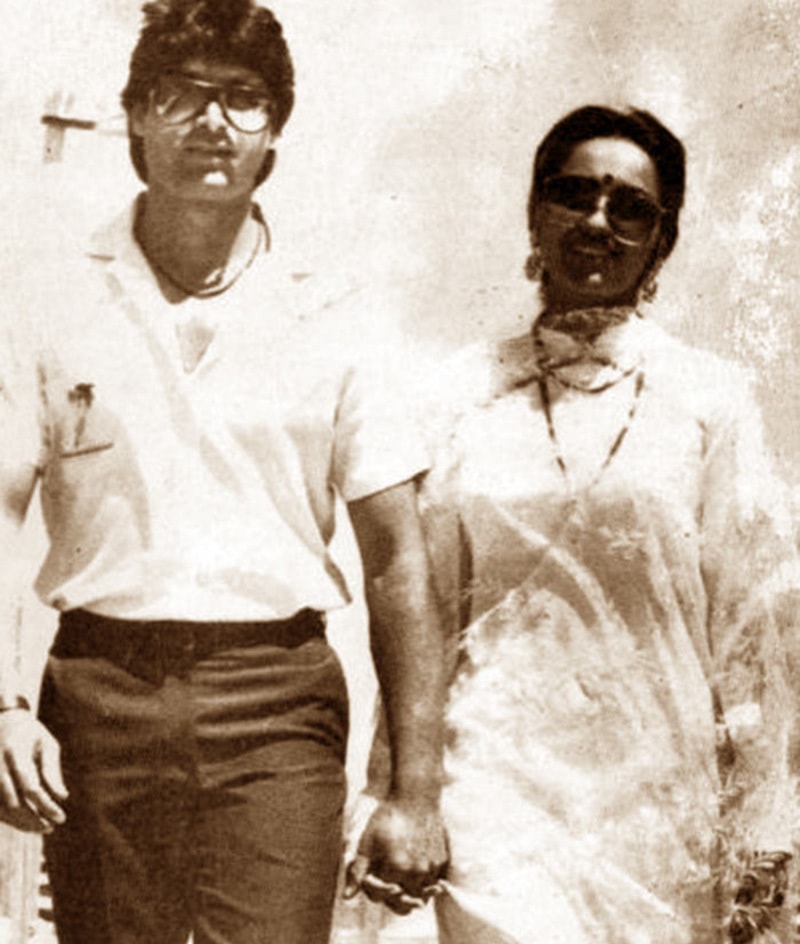 |
| Cross-border romance: Pakistani cricketer, Mohsin Khan, with Indian film actress, Reena Roy in 1984. Both got married and Roy moved to Pakistan. A few years later they divorced. |
 |
| Dhishoom! Pakistani action film hero, Sultan Rahi, jokes with former heavyweight boxing champion, Mohammad Ali in Lahore. Ali was visiting Pakistan in 1988. |
 |
| Two’s a crowd: Pakistan squash players, Jahansher Khan and Jahangir Khan, battle it out in Karachi in 1989. Both ruled the game as world champions in the 1980s and early 1990s. |
 |
| Gone too soon: Famous Urdu poetess, Parveen Shakir, reciting her poetry in Lahore in 1990. She was killed in a car accident in 1994. |
 |
| Logo of the first private TV channel in Pakistan, STN/NTM. It was launched in 1990. |
 |
| Victory: Pakistan cricket team celebrates victory against England in the final of the 1992 Cricket World Cup. |
 |
| 1993 cover of a Greatest Hits album by Pakistani pop band, The Vital Signs. The group was the country’s top pop act in the 1990s. |
 |
| A jam-packed Qaddafi Stadium in Lahore watches the final of the 1996 Cricket World Cup. |
Diversity in motion-II
 |
| Members of the Tableeghi Jamat (TJ) arrive in the organisation’s headquarters in Raiwind. The TJ is the country’s largest apolitical Sunni Islamic evangelical outfit. |
 |
| A Shia religious procession in Lahore. |
 |
| Women do the ‘dhamal’ outside the shrine of Sufi saint, Lal Shahbaz Qalandar in Shewan Sharif. |
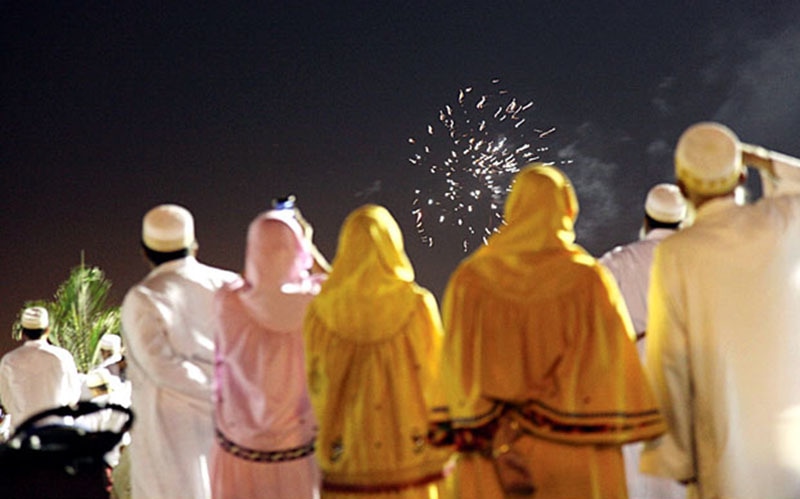 |
| Men and women from Pakistan’s Bohra community (a Shia sub-sect) watch fireworks in Karachi. |
 |
| Leader of the Agha Khan community in Pakistan meets Pakistan PM, Nawaz Sharif. |
 |
| Pakistani Christians praying in a Church in Lahore. |
 |
| Pakistani Hindus at a Hindu place of worship in Karachi. |
 |
| A Zoroastrian wedding in Karachi. |
 |
| A Sindhi family in traditional Sindhi dress. |
 |
| Punjabi women doing the Punjabi folk dance, the Luddi. |
 |
| Pushtun men perform the Khattak dance in the hills of Swat. |
 |
| A Pakistan Tourism Ministry’s poster depicting many facets of Baloch culture. |
 |
| A model dressed in traditional Mohajir dress. |
 |
| A fashion show in Karachi. |
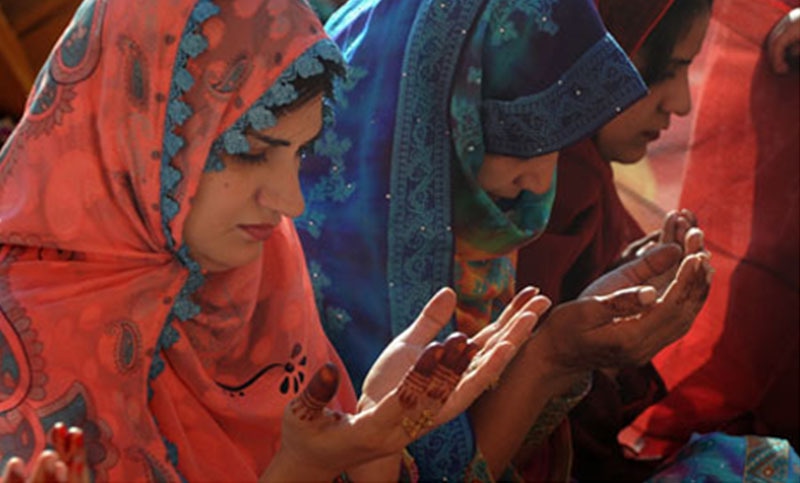 |
| Women at a Dars in Islamabad |
 |
| A trendy shopping mall in Karachi. |
 |
| A traditional bazaar in Lahore. |
 |
| Men and women graduates at a Pakistan Airforce passing out parade. |
 |
| The Pakistan National Assembly in session. |
Related:

